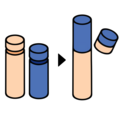Robertsonian translocation
Robertsonian translocation is a specific type of chromosome abnormality that involves the fusion of two specific chromosomes, namely the acrocentric chromosomes. This type of translocation, named after the American insect geneticist William R. B. Robertson, who first described a similar phenomenon in insects in 1916, is a common cause of genetic disorders, including Down syndrome and Patau syndrome.
Overview[edit]
In a Robertsonian translocation, the long arms of two acrocentric chromosomes have fused to form a single chromosome. This results in a carrier individual having 45 chromosomes in their cells instead of the usual 46. Despite this, they typically do not show any symptoms because the short arms of the acrocentric chromosomes, which are lost during the translocation, contain little genetic material.
Causes[edit]
Robertsonian translocations occur spontaneously during the formation of sperm or egg cells or may be inherited from a parent who carries the translocation. The most common types involve chromosome pairs 13 and 14, 14 and 21, or 15 and 22.
Effects[edit]
While carriers of a Robertsonian translocation are typically healthy, they have an increased risk of having children with genetic disorders. This is because their children may inherit an unbalanced set of chromosomes.
Diagnosis[edit]
Robertsonian translocations can be diagnosed through karyotyping, a laboratory procedure that allows visualization of an individual's chromosomes. Prenatal diagnosis methods such as amniocentesis and chorionic villus sampling can also detect these translocations in a developing fetus.
Management[edit]
There is no cure for Robertsonian translocations. However, individuals or couples who carry these translocations can benefit from genetic counseling to understand their reproductive risks and options.
See also[edit]
Ad. Transform your life with W8MD's Budget GLP-1 injections from $75


W8MD offers a medical weight loss program to lose weight in Philadelphia. Our physician-supervised medical weight loss provides:
- Weight loss injections in NYC (generic and brand names):
- Zepbound / Mounjaro, Wegovy / Ozempic, Saxenda
- Most insurances accepted or discounted self-pay rates. We will obtain insurance prior authorizations if needed.
- Generic GLP1 weight loss injections from $75 for the starting dose.
- Also offer prescription weight loss medications including Phentermine, Qsymia, Diethylpropion, Contrave etc.
NYC weight loss doctor appointmentsNYC weight loss doctor appointments
Start your NYC weight loss journey today at our NYC medical weight loss and Philadelphia medical weight loss clinics.
- Call 718-946-5500 to lose weight in NYC or for medical weight loss in Philadelphia 215-676-2334.
- Tags:NYC medical weight loss, Philadelphia lose weight Zepbound NYC, Budget GLP1 weight loss injections, Wegovy Philadelphia, Wegovy NYC, Philadelphia medical weight loss, Brookly weight loss and Wegovy NYC
|
WikiMD's Wellness Encyclopedia |
| Let Food Be Thy Medicine Medicine Thy Food - Hippocrates |
Medical Disclaimer: WikiMD is not a substitute for professional medical advice. The information on WikiMD is provided as an information resource only, may be incorrect, outdated or misleading, and is not to be used or relied on for any diagnostic or treatment purposes. Please consult your health care provider before making any healthcare decisions or for guidance about a specific medical condition. WikiMD expressly disclaims responsibility, and shall have no liability, for any damages, loss, injury, or liability whatsoever suffered as a result of your reliance on the information contained in this site. By visiting this site you agree to the foregoing terms and conditions, which may from time to time be changed or supplemented by WikiMD. If you do not agree to the foregoing terms and conditions, you should not enter or use this site. See full disclaimer.
Credits:Most images are courtesy of Wikimedia commons, and templates, categories Wikipedia, licensed under CC BY SA or similar.
Translate this page: - East Asian
中文,
日本,
한국어,
South Asian
हिन्दी,
தமிழ்,
తెలుగు,
Urdu,
ಕನ್ನಡ,
Southeast Asian
Indonesian,
Vietnamese,
Thai,
မြန်မာဘာသာ,
বাংলা
European
español,
Deutsch,
français,
Greek,
português do Brasil,
polski,
română,
русский,
Nederlands,
norsk,
svenska,
suomi,
Italian
Middle Eastern & African
عربى,
Turkish,
Persian,
Hebrew,
Afrikaans,
isiZulu,
Kiswahili,
Other
Bulgarian,
Hungarian,
Czech,
Swedish,
മലയാളം,
मराठी,
ਪੰਜਾਬੀ,
ગુજરાતી,
Portuguese,
Ukrainian





